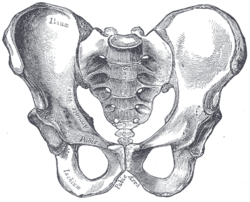Pubic arch
| Pubic arch | |
|---|---|
 Female pelvis (pubic arch labeled at bottom center.) | |
 Male pelvis (pubic arch labeled at bottom center.) | |
| Details | |
| Identifiers | |
| Latin | Arcus pubicus |
| FMA | 16951 |
The pubic arch is part of the pelvis. It is formed by the convergence of the inferior rami of the ischium and pubis on either side, below the pubic symphysis. The angle at which they converge is known as the subpubic angle.[1]
Function
The pubic arch is one of three notches (the one in front) that separated the eminences of the lower circumference of the true pelvis.
Clinical significance
Subpubic angle
The subpubic angle (or pubic angle) is the angle in the human body as the apex of the pubic arch, formed by the convergence of the inferior rami of the ischium and pubis on either side. The subpubic angle is important in forensic anthropology, in determining the sex of someone from skeletal remains. A subpubic angle of 50-82 degrees indicates a male; an angle of 90 degrees indicates a female.[2] Women have wider hips - a greater subpubic angle - in order to allow for child birth. Other sources operates with 50-60 degrees for males and 70-90 degrees in females.[1]
As seen in the picture , there is a distinctive difference between the pubic arch of a male and a female. This difference is found in the subpubic angle. The area in which the pubic arch is located is the pelvis, the area that is most different between male and female anatomy. The subpubic angle of a man is generally 50-60 degrees while that of a woman is generally 70-90 degrees.[1] A woman’s pubic arch needs to be wider in order to enable childbirth. The pelvic inlet of a female is also wider because the child’s head must pass through it. The pubic arch is also referred to as the ischiopubic arch.
 Female subpubic angle
Female subpubic angle Male subpubic angle
Male subpubic angle
References
This article incorporates text in the public domain from the 20th edition of Gray's Anatomy (1918)
- 1 2 3 Bojsen-Møller, Finn; Simonsen, Erik B.; Tranum-Jensen, Jørgen (2001). Bevægeapparatets anatomi [Anatomy of the Locomotive Apparatus] (in Danish) (12th ed.). pp. 257–258. ISBN 978-87-628-0307-7.
- ↑ Anthony J. Bertino. Forensic Science - Fundamentals and Investigations. South-Western Cengage Learning, 2000. ISBN 978-0-538-44586-3. Page 368